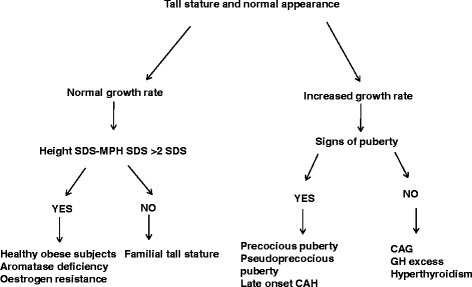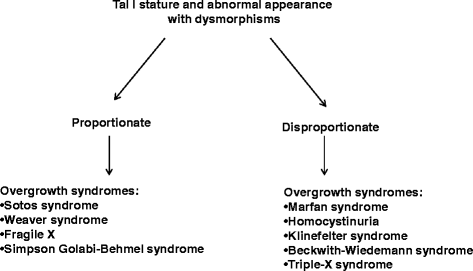Tall stature: a difficult diagnosis?
- PMID: 28774346
- PMCID: PMC5543750
- DOI: 10.1186/s13052-017-0385-5
Tall stature: a difficult diagnosis?
Abstract
Referral for an assessment of tall stature is less common than for short stature. Tall stature is defined as a height more than two standard deviations above the mean for age. The majority of subjects with tall stature show a familial tall stature or a constitutional advance of growth (CAG), which is a diagnosis of exclusion. After a careful physical evaluation, tall subjects may be divided into two groups: tall subjects with normal appearance and tall subjects with abnormal appearance. In the case of normal appearance, the paediatric endocrinologist will have to evaluate the growth rate. If it is normal for age and sex, the subject may be classified as having familial tall stature, CAG or obese subject, while if the growth rate is increased it is essential to evaluate pubertal status and thyroid status. Tall subjects with abnormal appearance and dysmorphisms can be classified into those with proportionate and disproportionate syndromes.A careful physical examination and an evaluation of growth pattern are required before starting further investigations. Physicians should always search for a pathological cause of tall stature, although the majority of children are healthy and they generally do not need treatment to cease growth progression.The most accepted and effective treatment for an excessive height prediction is inducing puberty early and leading to a complete fusion of the epiphyses and achievement of final height, using testosterone in males and oestrogens in females. Alternatively, the most common surgical procedure for reducing growth is bilateral percutaneous epiphysiodesis of the distal femur and proximal tibia and fibula.This review aims to provide up-to-date information and suggestions about the diagnosis and management of children with tall stature.
Keywords: Growth velocity; Height; Puberty; Syndromes; Tall stature.
Conflict of interest statement
Ethics approval and consent to participate
Not applicable.
Consent for publication
Not applicable.
Competing interests
The authors declare that they have no competing interests.
Publisher’s Note
Springer Nature remains neutral with regard to jurisdictional claims in published maps and institutional affiliations.
Figures
Similar articles
-
Tall Stature: A Challenge for Clinicians.Curr Pediatr Rev. 2019;15(1):10-21. doi: 10.2174/1573396314666181105092917. Curr Pediatr Rev. 2019. PMID: 30394212 Free PMC article. Review.
-
Evaluation of Short and Tall Stature in Children.Am Fam Physician. 2015 Jul 1;92(1):43-50. Am Fam Physician. 2015. PMID: 26132126 Review.
-
How to investigate a child with excessive growth?Ann Endocrinol (Paris). 2017 Jun;78(2):98-103. doi: 10.1016/j.ando.2017.04.006. Epub 2017 May 5. Ann Endocrinol (Paris). 2017. PMID: 28483364 Review.
-
[Investigation of tall stature in children: Diagnostic work-up, review of the main causes].Arch Pediatr. 2018 Feb;25(2):163-169. doi: 10.1016/j.arcped.2017.12.010. Epub 2018 Feb 1. Arch Pediatr. 2018. PMID: 29395883 Review. French.
-
What treatment for a child with tall stature?Ann Endocrinol (Paris). 2017 Jun;78(2):104-105. doi: 10.1016/j.ando.2017.04.007. Epub 2017 May 4. Ann Endocrinol (Paris). 2017. PMID: 28478947 Review.
Cited by
-
Tall Stature: A Challenge for Clinicians.Curr Pediatr Rev. 2019;15(1):10-21. doi: 10.2174/1573396314666181105092917. Curr Pediatr Rev. 2019. PMID: 30394212 Free PMC article. Review.
-
Epidemiology of disorders associated with tall stature in childhood: A 20-year birth cohort study.PLoS One. 2025 Apr 15;20(4):e0321798. doi: 10.1371/journal.pone.0321798. eCollection 2025. PLoS One. 2025. PMID: 40233073 Free PMC article.
-
Exome sequencing of patients with syndromic tall stature reveals four novel candidate genes.Endocr Connect. 2025 Jul 15;14(7):e250137. doi: 10.1530/EC-25-0137. Print 2025 Jul 1. Endocr Connect. 2025. PMID: 40577202 Free PMC article.
-
The Treatment of Growth Disorders in Childhood and Adolescence.Dtsch Arztebl Int. 2024 Feb 9;121(3):96-106. doi: 10.3238/arztebl.m2023.0247. Dtsch Arztebl Int. 2024. PMID: 38051162 Free PMC article. Review.
-
Tall stature and gigantism in transition age: clinical and genetic aspects-a literature review and recommendations.J Endocrinol Invest. 2024 Apr;47(4):777-793. doi: 10.1007/s40618-023-02223-z. Epub 2023 Oct 27. J Endocrinol Invest. 2024. PMID: 37891382 Free PMC article. Review.
References
-
- Wei C, Gregory JW. Physiology of normal growth. Paediatr Child Health. 2009;19:236–240. doi: 10.1016/j.paed.2009.02.007. - DOI
-
- de Waal WJ, Greyn-Fokker MH, Stijnen T, van Gurp EA, Toolens AM, de Munick Keizer-Schrama SM, Aarsen RS, Drop SL. Accuracy of final height prediction and effect of growth-reductive therapy in 362 constitutionally tall children. J Clin Endocrinol Metab. 1996;81:1206–1216. - PubMed
Publication types
MeSH terms
Substances
LinkOut - more resources
Full Text Sources
Other Literature Sources



